Beginners Guides
How Long Does Carpet Last in High-Traffic Areas
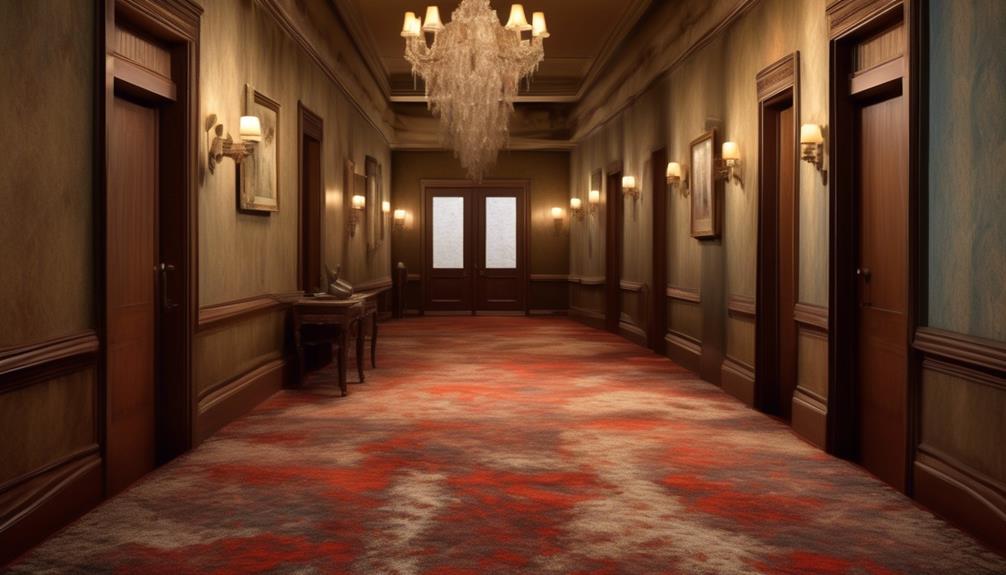
We've all heard that the average lifespan of carpet in high-traffic areas is around 3 to 5 years, but what factors actually contribute to this timeframe?
As homeowners, we invest a significant amount of time and money into selecting the perfect carpet for our spaces, yet understanding how to maximize its longevity can be a mystery.
But fear not, as we dive into the key factors and practical tips that can help us make the most of our carpet investment.
Key Takeaways
- Material quality, density, and maintenance routines determine the longevity of carpet in high-traffic areas.
- Carpet durability is crucial in high-traffic conditions.
- The type of carpet fibers, construction, and installation affect the lifespan of carpet in high-traffic areas.
- Regular maintenance practices, such as regular vacuuming, periodic deep cleaning, and using carpet protection, can help extend the lifespan of carpet in high-traffic areas.
Factors Affecting Carpet Longevity
In high-traffic areas, the longevity of carpets is significantly influenced by factors such as material quality, density, and maintenance routines.
High quality materials, such as wool or nylon, and proper installation techniques play a crucial role in ensuring the durability of carpets in high-traffic areas.
The density of the carpet fibers, measured in ounces per square yard, also contributes to its ability to withstand heavy foot traffic.
Regular vacuuming, at least once a week, is essential in removing dirt and debris that can cause premature wear and tear.
Additionally, professional cleaning every 12-18 months is crucial for maintaining the carpet's appearance and extending its lifespan.
The combination of high-quality materials, expert installation, and diligent maintenance routines is paramount in maximizing the lifespan of carpets in high-traffic areas.
Understanding these factors and implementing appropriate measures can significantly enhance the durability and appearance retention of carpets, ultimately providing a longer service life in demanding environments.
Average Lifespan of Carpet in High-Traffic Areas

The influential role of material quality, density, and maintenance routines in determining the longevity of carpets in high-traffic areas directs attention to understanding the average lifespan of such carpets. Carpet durability is a key factor in assessing how long a carpet can withstand high-traffic conditions. In high-traffic areas, carpets are subjected to significant wear and tear, which necessitates a thorough understanding of their average lifespan. Wear patterns, influenced by foot traffic and maintenance practices, play a crucial role in determining how long a carpet can maintain its integrity in such areas.
Understanding the average lifespan of carpets in high-traffic areas requires a comprehensive analysis of various factors. These include the type of carpet fibers, construction, and the quality of installation. Additionally, the frequency and effectiveness of maintenance, such as vacuuming and professional cleaning, significantly impact the longevity of carpets in high-traffic areas.
Analyzing wear patterns and the overall condition of carpets in high-traffic areas provides valuable insights into their average lifespan. By considering these factors, one can better gauge the expected durability of carpets in such demanding environments.
Signs of Wear and Tear on Carpet
Examining the carpet for changes in texture, color, and resilience can reveal early indicators of wear and tear caused by high-traffic conditions. Detecting these signs is crucial for effective carpet maintenance and ensuring its longevity. Here are key indicators to watch for:
- Fiber Fraying: Look for frayed or unraveled carpet fibers, especially along the edges or seams. This can indicate excessive foot traffic, causing the fibers to break down and lose their structural integrity.
- Matting and Crushing: High-traffic areas may show signs of matting, where the fibers become flattened and entangled. Similarly, crushing occurs when the carpet pile becomes compressed, leading to a loss of resilience.
- Discoloration: Noticeable changes in the carpet's color, particularly in areas with heavy foot traffic, can be a sign of wear. This may be due to dirt and grime becoming embedded in the fibers or fading from exposure to sunlight.
- Loose or Missing Tufts: Keep an eye out for loose or missing tufts, which can result from wear and tear. These can create uneven patches on the carpet's surface, affecting both its appearance and functionality.
Regularly inspecting your carpet for these wear and tear indicators is essential for maintaining its condition and maximizing its lifespan.
Tips for Extending Carpet Lifespan

To maximize the lifespan of carpet in high-traffic areas, it's essential to implement effective maintenance strategies and proactive care routines.
One of the most crucial tips for extending carpet lifespan is to invest in carpet protection. This can include using rugs or mats in high-traffic pathways to reduce the direct wear and tear on the carpet fibers.
Additionally, heavy-duty cleaning is vital for maintaining the integrity of the carpet. Regular vacuuming, at least once a week, is necessary to remove dirt and debris that can become embedded in the carpet fibers and cause damage over time. For high-traffic areas, more frequent vacuuming may be required.
In addition to regular vacuuming, periodic deep cleaning is essential to remove stubborn stains and deeply embedded dirt. This can be achieved through professional steam cleaning or using a carpet cleaning machine.
Maintenance Practices for High-Traffic Areas
Implementing effective maintenance practices for high-traffic areas is crucial for extending the lifespan of carpets. One key strategy is to invest in carpet protection, such as using rugs or mats to reduce direct wear and tear on the carpet fibers.
In addition to using protective measures, regular vacuuming and spot cleaning are essential for preserving the appearance and integrity of carpets in high-traffic areas.
Here are some key maintenance practices for high-traffic areas:
- Regular Vacuuming: Frequent vacuuming helps to remove dirt, debris, and particles that can become embedded in the carpet fibers, causing premature wear. High-traffic areas may require more frequent vacuuming than low-traffic areas to prevent the buildup of dirt and grime.
- Spot Cleaning: Accidents and spills are inevitable in high-traffic areas. Promptly addressing spills and stains through spot cleaning can prevent them from becoming permanent blemishes on the carpet. Using appropriate cleaning solutions and techniques is crucial to effectively removing stains without damaging the carpet fibers.
- Professional Cleaning: Periodic professional cleaning is recommended for high-traffic areas to deep clean the carpet and remove stubborn dirt and residues that regular vacuuming and spot cleaning may not eliminate.
- Rotation of Furniture and Rugs: Regularly repositioning furniture and rugs in high-traffic areas can help distribute the wear and prevent excessive localized damage to the carpet fibers.
Frequently Asked Questions
What Are the Best Carpet Materials for High-Traffic Areas?
We've found that the best carpet materials for high-traffic areas are nylon and polyester due to their durability. These fibers are resilient and can withstand heavy foot traffic, making them ideal for areas with lots of activity.
Nylon is particularly known for its strength and ability to bounce back from compression, while polyester offers excellent stain resistance.
Regular vacuuming and professional cleaning can help maintain these durable carpets for long-lasting performance.
Can Regular Vacuuming and Cleaning Really Extend the Lifespan of Carpet in High-Traffic Areas?
Regular vacuuming and cleaning can significantly extend the lifespan of carpet in high-traffic areas. Maintenance plays a crucial role in preserving the durability of carpets subjected to heavy foot traffic.
It helps to minimize wear and tear, prevent dirt buildup, and maintain the overall appearance. By following a consistent cleaning routine, we can effectively prolong the lifespan of the carpet and ensure it withstands the demands of high-traffic areas.
Are There Any Specific Carpet Padding or Underlayment Recommendations for High-Traffic Areas?
When it comes to carpet padding and underlayment for high-traffic areas, durability is key. We recommend selecting padding with high density and good support to withstand constant use.
Additionally, choosing underlayment that provides moisture resistance and noise reduction can contribute to the longevity of the carpet.
Regular maintenance, including professional cleaning and prompt spot treatment, is essential for preserving the carpet's lifespan in these areas.
How Can I Tell if My Carpet Needs to Be Replaced Versus Just Professionally Cleaned in a High-Traffic Area?
We can identify signs that indicate it's time to replace the carpet in high-traffic areas through a professional inspection. Wear patterns, matting, and loss of texture are key indicators.
Regular maintenance techniques, such as vacuuming and professional cleaning, can extend the carpet's lifespan. However, once these signs are evident, replacement becomes necessary to maintain the appearance and functionality of the carpet in high-traffic areas.
Are There Any Carpet Treatments or Coatings That Can Help Protect Against Wear and Tear in High-Traffic Areas?
Sure, there are various carpet coatings and protective treatments that can significantly extend the durability of high-traffic areas. These coatings act as a barrier against wear and tear, reducing the impact of foot traffic.
Additionally, implementing maintenance techniques such as regular vacuuming and professional cleaning can further enhance the longevity of the carpet.
It's important to consider these treatments and techniques to ensure the carpet withstands the demands of high-traffic areas effectively.
Conclusion
In conclusion, the longevity of carpet in high-traffic areas depends on various factors such as material quality, maintenance practices, and level of foot traffic.
With proper care and maintenance, a well-constructed carpet can last for many years.
However, extreme wear and tear can significantly reduce its lifespan.
By following recommended maintenance practices and investing in high-quality carpet, you can ensure that your carpet will last longer than a lifetime.
- About the Author
- Latest Posts
Introducing Ron, the home decor aficionado at ByRetreat, whose passion for creating beautiful and inviting spaces is at the heart of his work. With his deep knowledge of home decor and his innate sense of style, Ron brings a wealth of expertise and a keen eye for detail to the ByRetreat team.
Ron’s love for home decor goes beyond aesthetics; he understands that our surroundings play a significant role in our overall well-being and productivity. With this in mind, Ron is dedicated to transforming remote workspaces into havens of comfort, functionality, and beauty.
Beginners Guides
The Evolution of Cruise Ship Amenities and Design: A How-To Guide
Luxuriate in the evolution of cruise ship amenities and design, discovering the secrets behind the transformation that will leave you yearning for more.
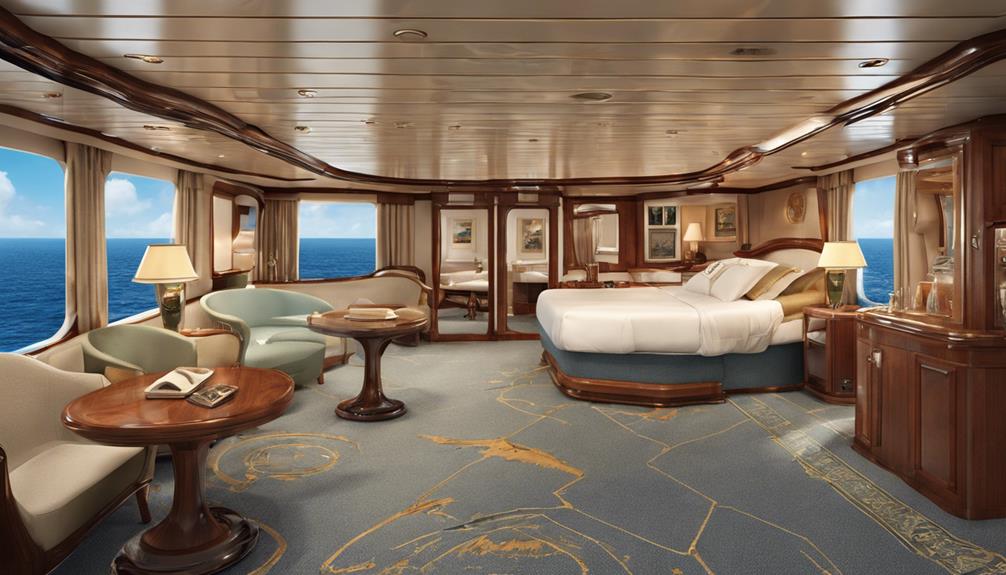
As we set sail through the intricate web of cruise ship evolution, we navigate the waters of design and amenities like seasoned captains. From the humble beginnings of passenger spaces to the grandeur of modern luxury liners, the journey unfolds with each wave of innovation.
Join us as we uncover the secrets behind the transformation of cruise ship experiences, offering a glimpse into the future of seafaring splendor.
Key Takeaways
- Cruise ship amenities have evolved to offer upscale dining, entertainment, and relaxation options.
- Technological advancements enhance passenger comfort and provide a seamless cruising experience.
- Modern mega-ships feature expansive shopping, fitness, spa, and entertainment facilities for a luxurious stay.
- Embracing sustainable practices is a growing trend among cruise companies to promote eco-friendly operations.
Historical Roots of Cruise Ship Design
The evolution of cruise ship design can be traced back to the early 19th century when packet ships first introduced dedicated passenger spaces in 1818. This marked a significant shift in maritime travel, where the focus began to shift towards providing comfortable accommodations for travelers.
As time progressed, the design of ocean liners evolved, with pioneers like Albert Ballin introducing luxury elements in the early 1890s. This set the stage for opulent cruise ship design, with a growing emphasis on amenities and passenger comfort.
One notable example of this evolution was Cunard's Queen Mary, which debuted in 1934 showcasing elegant Art Deco features. The ship's interior design influenced future cruise ships, inspiring a trend towards more sophisticated and stylish aesthetics.
As the demand for luxury travel grew in the early 1900s, ship designs became increasingly opulent, with a focus on attracting passengers through lavish amenities and elegant surroundings. German modernism in the 1930s also played a role in shaping cruise ship aesthetics, incorporating sleek and modern elements into the design to create a unique and luxurious experience on the high seas.
Emergence of Luxurious Onboard Amenities

With the rise of modern cruise ship construction techniques and evolving consumer demands, a new era of onboard luxury amenities has emerged to redefine the passenger experience at sea. Cruise ships now boast a plethora of upscale offerings, from extravagant restaurants helmed by renowned chefs to chic bars and restaurants serving exotic cocktails and gourmet cuisine. These onboard amenities cater to the diverse tastes of passengers, providing a sophisticated dining experience that rivals top establishments on land.
In addition to fine dining options, cruise ships have also transformed their public areas into luxurious spaces designed for relaxation and entertainment. Lavish lounges, stylish theaters, and upscale shopping boutiques offer passengers a range of activities to indulge in during their voyage. Whether seeking a tranquil retreat or a vibrant social scene, these amenities and entertainment options ensure that passengers have a memorable and indulgent experience while at sea. The evolution of onboard amenities has elevated the cruise ship experience, allowing travelers to enjoy the height of luxury while exploring the world's oceans.
Technological Innovations in Cruise Ships
Amidst the evolution of cruise ship amenities towards luxurious onboard experiences, the integration of technological innovations has revolutionized the industry's approach to enhancing passenger comfort and entertainment. Modern cruise lines have embraced cutting-edge technologies to create a seamless and enjoyable experience for travelers.
- Diesel-Electric Propulsion Systems: Cruise ships now utilize advanced diesel-electric propulsion systems to enhance fuel efficiency and overall performance. These systems not only reduce environmental impact but also provide a smoother sailing experience for passengers.
- Stabilizer Systems: To combat the discomfort caused by rough seas, cruise ships have incorporated stabilizer systems. These systems work to stabilize the vessel, ensuring a more comfortable journey for guests, even in challenging maritime conditions.
- Interactive Entertainment: Modern cruise ships are designed specifically to offer a wide range of entertainment options, including gourmet restaurants, shopping malls, and even casinos. These interactive amenities provide passengers with a luxurious onboard experience, turning the cruise ship into a destination in itself.
Evolution of Modern Mega-Ship Features

Exploring the waters of the cruise industry's evolution, one cannot overlook the grand transformation in the features of modern mega-ships. These floating cities on the ocean have redefined cruise ship design by offering an array of amenities that cater to every passenger's desires. From expansive shopping arcades to cutting-edge gyms, tranquil spa centers, and lively nightclubs, modern mega-ships provide passengers with an unparalleled onboard experience.
Below is a table highlighting the evolution of modern mega-ship features:
| Feature | Description |
|---|---|
| Expansive Shopping Arcades | Offering a wide range of retail options for passengers to indulge in some retail therapy at sea. |
| Cutting-Edge Gyms | Equipped with state-of-the-art fitness facilities, ensuring passengers can maintain their workout routines. |
| Tranquil Spa Centers | Providing relaxation and rejuvenation with a variety of spa treatments and wellness activities. |
| Lively Nightclubs | Offering vibrant nightlife experiences with live music, dancing, and entertainment into the late hours. |
| Diverse Entertainment Options | From rock climbing to wine-tasting to Broadway-style shows, there's something for everyone onboard. |
Embracing Sustainable Practices for Cruising
Embracing sustainable practices for cruising has become a pivotal focus for many cruise companies, driving significant shifts towards eco-friendly technologies and designs. The cruise industry is actively incorporating responsible environmental practices to minimize its impact on the planet.
Here are three key ways in which the industry is embracing sustainability:
- Integration of Eco-Friendly Technologies: Many cruise companies are investing in eco-friendly technologies such as solar panels and alternative fuels to reduce emissions and promote cleaner operations onboard. These innovations not only benefit the environment but also enhance the overall cruising experience for passengers.
- Incorporation of Sustainable Design: Newer cruise ships are being designed with sustainability in mind, incorporating features that conserve energy and reduce waste. From advanced waste management systems to energy-efficient lighting, sustainable design elements are becoming standard in modern cruise ship amenities.
- Promotion of Responsible Environmental Practices: The commitment to sustainability isn't just a trend but a necessity for the long-term success and reputation of the cruise industry. By promoting responsible environmental practices, cruise companies are shaping the future of cruising towards a more environmentally conscious and sustainable approach.
Conclusion
As we reflect on the evolution of cruise ship amenities and design, we're reminded of the juxtaposition between the historical roots of simplicity and the modern era of extravagance.
From the emergence of luxurious onboard amenities to the embrace of sustainable practices, the cruise industry has continuously evolved to meet the changing needs and desires of passengers.
With each technological innovation and architectural enhancement, we see a blend of tradition and progress shaping the future of cruising.
- About the Author
- Latest Posts
Introducing Ron, the home decor aficionado at ByRetreat, whose passion for creating beautiful and inviting spaces is at the heart of his work. With his deep knowledge of home decor and his innate sense of style, Ron brings a wealth of expertise and a keen eye for detail to the ByRetreat team.
Ron’s love for home decor goes beyond aesthetics; he understands that our surroundings play a significant role in our overall well-being and productivity. With this in mind, Ron is dedicated to transforming remote workspaces into havens of comfort, functionality, and beauty.
Beginners Guides
Best Time of Year to Go on an Alaskan Cruise
When is the best time to embark on an Alaskan cruise? Let's uncover the seasonal secrets that can transform your journey.
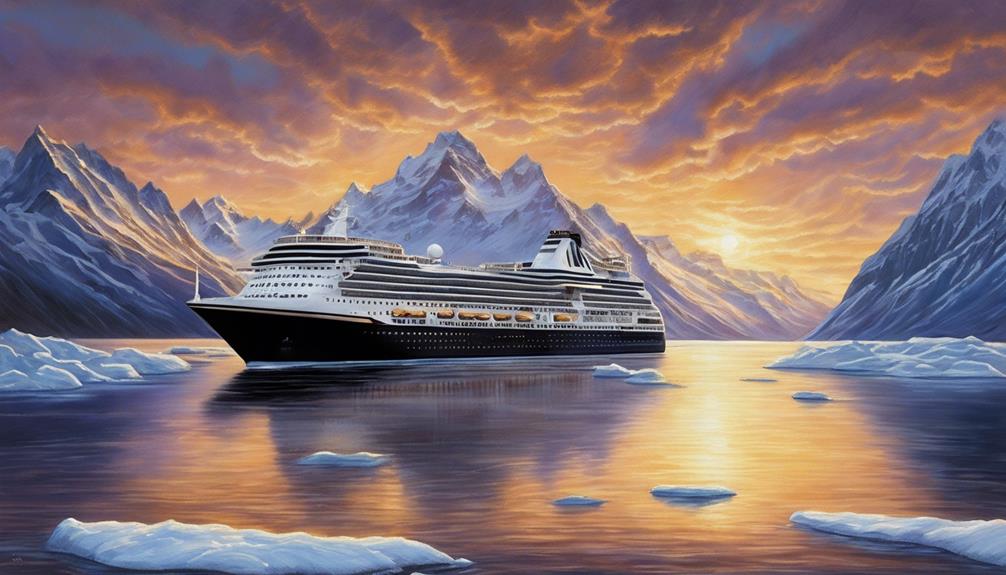
When considering the best time of year for an Alaskan cruise, you might not be aware that the season can greatly impact your experience.
From the best moments for wildlife sightings to the chance to witness the elusive Northern Lights, each period offers unique advantages.
Understanding the nuances of timing can truly enhance your Alaskan adventure and make sure you get the most out of your cruise.
Key Takeaways
- Late-May to mid-June: optimal for vibrant wildlife observation during peak salmon runs.
- Mid-June to August: best for comfortable weather, outdoor activities, and Alaskan cruise start.
- Early September: tranquil ambiance with fewer crowds, ideal for serene wildlife encounters.
- Late September: prime time for Northern Lights viewing, offering intense and colorful displays in Alaska.
Ideal Months for Alaskan Wildlife
Late-May to mid-June offers the best opportunity for observing vibrant Alaskan wildlife due to the peak of salmon runs and the presence of mothers with their calves/cubs. This period marks the awakening of wildlife in Alaska, with moose, sheep, mountain goats, and black bears becoming visible as they emerge in search of food and mating opportunities amidst the new vegetation. The cooler temperatures during late May to mid-June create a comfortable environment for wildlife excursions, allowing for longer and more enjoyable wildlife viewing experiences.
Additionally, the reduced number of tourists during this time provides a more intimate and authentic Alaskan wildlife encounter. With more daylight hours available, visitors have ample time to witness the diverse wildlife activities that unfold during these months. The vibrancy of the wildlife scene, coupled with the lush greenery of the new vegetation, sets the stage for an unforgettable Alaskan wildlife adventure that showcases the true beauty and wilderness of this spectacular region.
Optimal Time for Good Weather
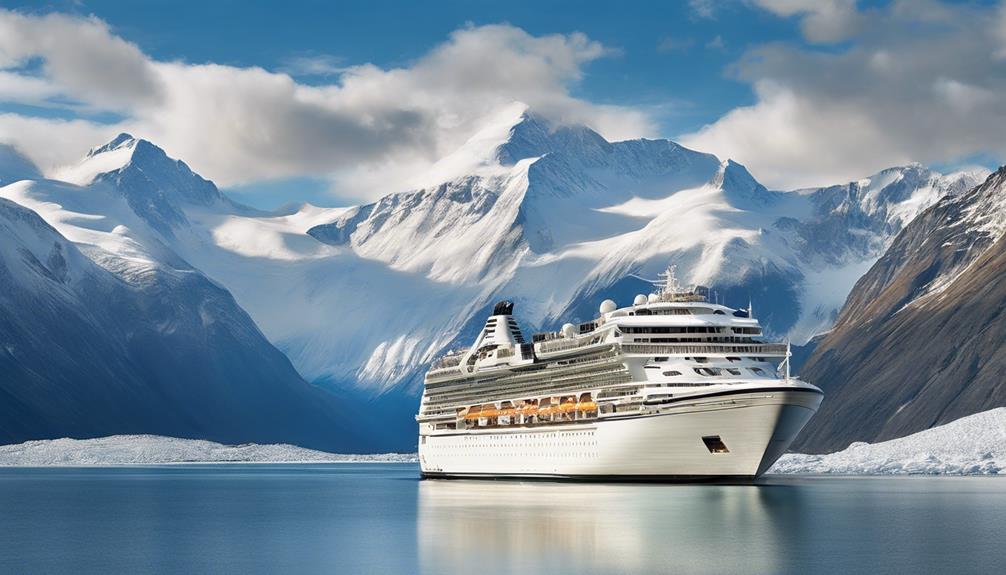
As we move into the discussion on the best time for good weather in Alaska, mid-June to August stands out as the recommended period for starting on an Alaskan cruise due to the warm temperatures and extended daylight hours. During this time, temperatures range from 50-70°F, creating pleasant conditions for outdoor activities and wildlife sightings. The long days with up to 22 hours of sunlight provide ample time for cruising and exploring the breathtaking landscapes of Alaska. Common wildlife sightings in mid-summer include brown bears, moose, beluga and humpback whales, orcas, seals, and dolphins. Choosing to cruise in mid-June to August ensures an optimal experience with comfortable weather conditions, perfect for enjoying all that Alaska has to offer.
| Weather | Best |
|---|---|
| Temperature | 50-70°F |
| Daylight Hours | Up to 22 hours |
| Wildlife | Brown bears, moose, belugas, humpbacks, orcas, seals, dolphins |
| Activities | Cruising, exploring, wildlife spotting |
| Experience | Pleasant weather, ideal for outdoor adventures |
Prime Season to Avoid Crowds
To maximize your Alaskan cruise experience with fewer crowds and a peaceful ambiance, consider starting on your journey in early September. This time offers a perfect blend of cooler temperatures, stunning fall foliage, and wildlife spectacles.
Imagine witnessing humpback whales breaching, salmon spawning, and caribou gracefully migrating in tranquil waters, away from the summer crowds. Early September marks a shift period in Alaska, where nature prepares for autumn, creating serene surroundings ideal for an intimate cruise experience.
The reduced tourist congestion during this time allows for a more personal connection with the breathtaking landscapes and wildlife encounters. Picture yourself enjoying the Alaskan wilderness in a quieter setting, appreciating the beauty and majesty of this unique destination without the hustle and bustle of peak season.
Embrace the opportunity for a peaceful and unforgettable journey through Alaska's waters during early September.
Best Time for Northern Lights

For best viewing of the mesmerizing Northern Lights in Alaska, consider planning your trip for late September. This time of year offers ideal conditions to witness the dancing lights in the Arctic Sky, creating a truly mesmerizing phenomenon.
Here are four reasons why late September is the best time for experiencing the Northern Lights in Alaska:
- Solar Activity Peaks: Late September sees an increase in solar activity, leading to more intense and vibrant displays of the Northern Lights.
- Solar Wind Particles: During this time, solar wind particles collide with air molecules, producing stunning colors that light up the night sky.
- Great Viewing Opportunities: Alaska provides excellent viewing opportunities for those seeking to marvel at the beauty of the Northern Lights.
- Unforgettable Experience: Immerse yourself in the magic of the Northern Lights as they paint the sky with their enchanting glow during late September.
Recommended Time for Glacier Viewing
The prime time for experiencing the awe-inspiring beauty of Alaska's glaciers is during the warm summer months of June, July, and August. This period aligns with the peak cruise season, offering ideal conditions for glacier viewing. During summer, glaciers are at their most active and dynamic state, showcasing spectacular calving events and intricate ice formations. The longer daylight hours in the summer months provide ample opportunities for extended glacier exploration, allowing you to witness the dynamic nature of these icy wonders.
When planning your Alaskan cruise adventure, be sure to select a cruise itinerary that includes glacier viewing as a highlight. This guarantees that you won't miss out on the opportunity to witness these natural marvels up close. Seeing glaciers in person is a truly unforgettable experience, offering a glimpse into the raw power and beauty of these majestic ice formations. Prepare to be mesmerized by the sight of dynamic glaciers during your Alaskan cruise, creating memories that will last a lifetime.
Conclusion
To sum up, no matter what time of year you choose to go on an Alaskan cruise, you're guaranteed to have a memorable experience.
Did you know that Alaska has over 100,000 glaciers, covering about 29,000 square miles of the state?
With each season offering its own unique attractions, there's something for everyone to enjoy on an Alaskan cruise.
So pack your bags and get ready for an adventure of a lifetime!
- About the Author
- Latest Posts
Introducing Ron, the home decor aficionado at ByRetreat, whose passion for creating beautiful and inviting spaces is at the heart of his work. With his deep knowledge of home decor and his innate sense of style, Ron brings a wealth of expertise and a keen eye for detail to the ByRetreat team.
Ron’s love for home decor goes beyond aesthetics; he understands that our surroundings play a significant role in our overall well-being and productivity. With this in mind, Ron is dedicated to transforming remote workspaces into havens of comfort, functionality, and beauty.
Beginners Guides
Uncover Rich Mediterranean Cultures on Silversea's Grand Voyage: A History Guide
Yield to the allure of the Mediterranean's historical tapestry on Silversea's Grand Voyage – where hidden stories await to be unveiled.
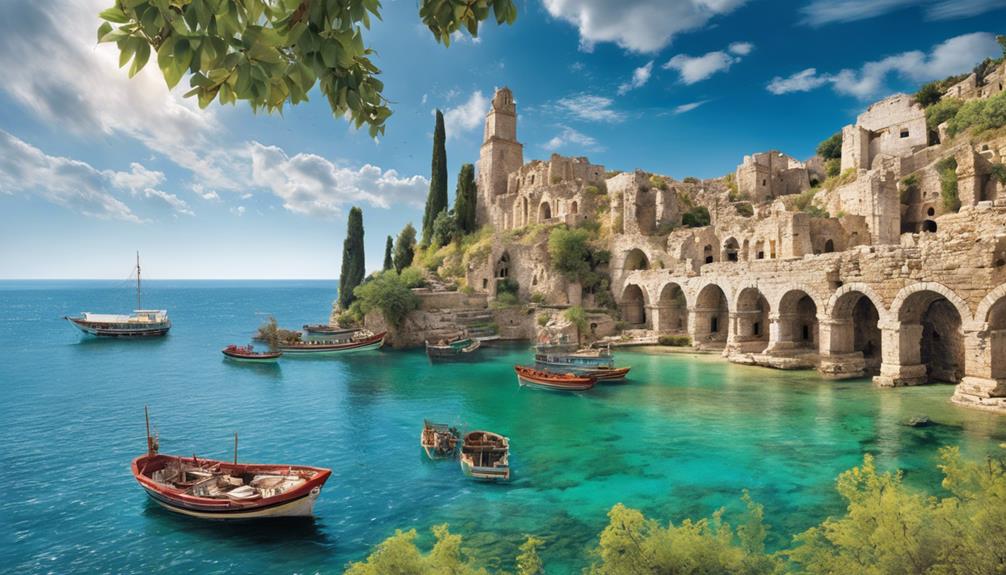
While the idea of exploring the rich Mediterranean cultures with Silversea's Grand Voyage might seem like a well-trodden path, the depth and intricacies of this historical journey are bound to surprise even the most seasoned travelers.
Discover not just the famous landmarks, but the hidden gems and untold stories waiting to be uncovered along this immersive voyage.
From the whispers of ancient civilizations to the echoes of diverse traditions, there is something remarkable about the Mediterranean that beckons us to investigate further into its enthralling past.
Key Takeaways
- Explore ancient wonders and civilizations like Acropolis and Colosseum.
- Immerse in diverse cultural encounters in historic cities along the voyage.
- Witness the enduring legacy of Mediterranean civilizations on modern society.
- Unveil the richness of Mediterranean cultures through art, cuisine, and traditions.
Mediterranean Heritage and Civilization Highlights
Exploring the Mediterranean Heritage and Civilization Highlights reveals a tapestry woven with the threads of ancient empires, cultural exchanges, and enduring legacies. The Mediterranean region boasts a rich heritage stemming from illustrious ancient civilizations like the Greeks, Romans, Phoenicians, and Egyptians. These civilizations have left an indelible mark on history, with key historical sites such as the Acropolis in Athens, the Colosseum in Rome, the Pyramids of Giza in Egypt, and the ancient city of Carthage in Tunisia standing as affirmations to their grandeur.
Being a crossroads of cultures, the Mediterranean has been a melting pot of diverse influences, resulting in a vibrant tapestry of art, architecture, cuisine, and traditions. The region's history is punctuated by significant events such as the rise and fall of empires, the propagation of religions like Christianity and Islam, and the evolution of democratic ideals. The lasting legacy of Mediterranean civilizations can be seen in the shaping of Western civilization through contributions in philosophy, literature, science, and governance.
Silversea's Grand Voyage Itinerary Insights
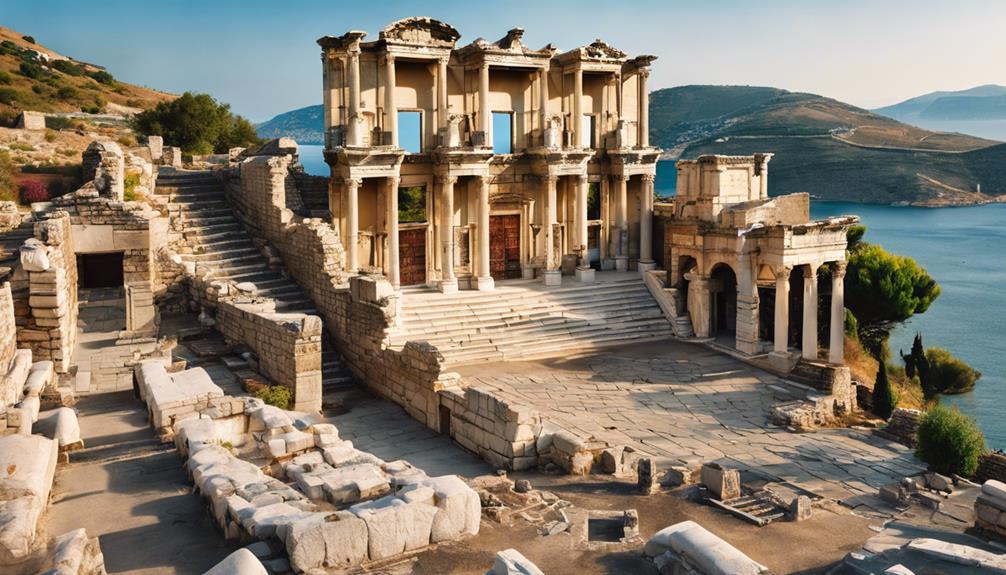
Starting on Silversea's Grand Voyage through the Mediterranean reveals a curated journey steeped in rich cultural experiences and historical marvels waiting to be explored. The itinerary is carefully crafted to immerse travelers in the diverse landscapes and ancient landmarks of the region. Below is a table highlighting some of the key insights into what guests can expect on this extraordinary voyage:
| Experience | Destination | Highlights |
|---|---|---|
| Iconic Sites | Athens, Rome | Acropolis, Colosseum |
| Historic Treasures | Ephesus, Valletta | Ancient city, UNESCO World Heritage Site |
| Cultural Immersion | Istanbul, Jerusalem | Diverse cultures, Excursions to iconic landmarks |
| Rich Heritage Exploration | Naples, Malta | Pyramids of Giza, Mediterranean history exploration |
Silversea's Grand Voyage offers a blend of history, culture, and adventure, making it an unforgettable journey for those seeking to uncover the wonders of the Mediterranean.
Ancient Wonders of the Mediterranean Revealed
As we set sail on a journey through the Mediterranean's historical tapestry, the ancient wonders of this region reveal an enthralling narrative of civilization and legacy.
Ancient Wonders of the Mediterranean:
- Iconic Sites: Explore the past by discovering renowned landmarks like the Acropolis in Athens and the Colosseum in Rome, witnessing firsthand the architectural marvels that have withstood the test of time.
- Guided Tours and Insights: Begin on guided tours offering expert insights into the rich history and cultural heritage of the Mediterranean, providing a deeper understanding of the civilizations that once flourished along these shores, from the Phoenicians to the Romans.
- Art, Architecture, and Mythology: Immerse yourself in the art, architecture, and mythology of ancient Mediterranean civilizations, gaining a profound appreciation for their influence on modern society and the enduring legacy they've left behind.
Embark on a voyage that not only traverses the seas but also journeys through the annals of time, unraveling the enthralling stories woven into the fabric of the Mediterranean's ancient wonders.
Cultural Encounters Along the Grand Voyage
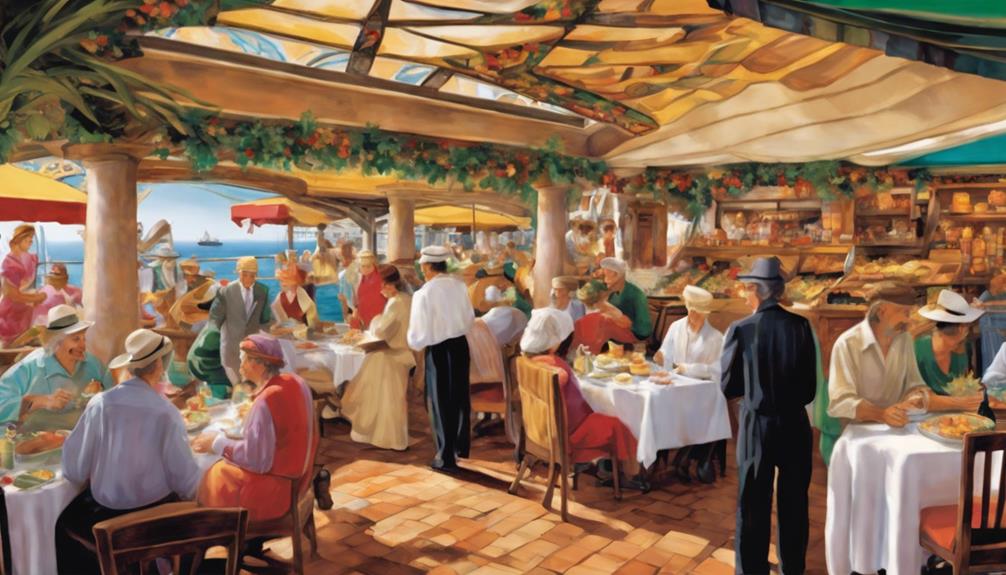
Starting on the grand voyage through the Mediterranean, we investigate a mosaic of cultural encounters that offer a rich tapestry of history and traditions waiting to be explored.
From the historic cities of Venice, Istanbul, and Barcelona to the ancient ruins in Greece such as the Acropolis in Athens and the Palace of Knossos in Crete, each stop along the journey presents a unique opportunity for cultural immersion.
In Malta, travelers can engage with local traditions and savor the distinctive cuisine that reflects a blend of Mediterranean and North African influences. Egypt beckons with its iconic sites like the Pyramids of Giza and the Sphinx, inviting us to explore its rich history.
Croatia, with its diverse cultural heritage ranging from Roman ruins to medieval architecture in cities like Dubrovnik, provides a glimpse into the intricate tapestry of Mediterranean cultures waiting to be unravelled. Each encounter promises a deeper understanding and appreciation of the region's vibrant and multifaceted identity.
Unveiling the Diversity of Mediterranean Cultures
Diving into the depths of the Mediterranean tapestry, we uncover a myriad of cultures that intertwine to create a rich and diverse mosaic of traditions and histories. The Mediterranean region, encompassing countries like Italy, Greece, Spain, Turkey, and Egypt, boasts a cultural extravaganza unlike any other.
Here's a glimpse into the kaleidoscope of Mediterranean cultures:
- Italy: Indulge in the sumptuous flavors of Italian cuisine, explore ancient Roman ruins, and witness the grandeur of Renaissance art in cities like Rome, Florence, and Venice.
- Greece: Immerse yourself in the birthplace of democracy and philosophy, savor traditional Greek dishes like moussaka and souvlaki, and marvel at iconic landmarks such as the Acropolis and Delphi.
- Spain: Experience the passion of flamenco, taste authentic paella, and wander through historic sites like the Alhambra in Granada and the Sagrada Familia in Barcelona.
These Mediterranean cultures offer a treasure trove of traditions, culinary delights, historical landmarks, and vibrant festivals waiting to be explored.
Conclusion
As we conclude our journey through the Mediterranean with Silversea's Grand Voyage, we've unraveled the intricate tapestry of cultures that define this historic region. From the ancient wonders of Italy and Greece to the vibrant markets of Turkey and the picturesque islands of Malta and Crete, we've witnessed the rich diversity that makes the Mediterranean a treasure trove of heritage and civilization.
Our exploration has confirmed that the Mediterranean truly is a melting pot of cultures waiting to be discovered.
- About the Author
- Latest Posts
Introducing Ron, the home decor aficionado at ByRetreat, whose passion for creating beautiful and inviting spaces is at the heart of his work. With his deep knowledge of home decor and his innate sense of style, Ron brings a wealth of expertise and a keen eye for detail to the ByRetreat team.
Ron’s love for home decor goes beyond aesthetics; he understands that our surroundings play a significant role in our overall well-being and productivity. With this in mind, Ron is dedicated to transforming remote workspaces into havens of comfort, functionality, and beauty.
-

 Vetted5 days ago
Vetted5 days ago15 Best Printers of 2024: Top Picks and Expert Reviews
-

 Vetted7 days ago
Vetted7 days ago15 Best Tile Sealers for Long-Lasting Protection and Shine
-

 Vetted2 weeks ago
Vetted2 weeks ago15 Best Smelling Floor Cleaners That Will Leave Your Home Fresh and Inviting
-

 Vetted1 week ago
Vetted1 week ago14 Best Power Scrubbers for Showers That Will Transform Your Cleaning Routine
-

 Vetted2 days ago
Vetted2 days ago15 Best LED Dimmer Switches With No Flicker: Ultimate Guide for a Flicker-Free Lighting Experience
-

 Vetted2 days ago
Vetted2 days ago15 Best Evergreen Plants for Shade Gardens: A Complete Guide
-

 Mardi Gras Decoration4 days ago
Mardi Gras Decoration4 days agoWhat Do the Symbols of Mardi Gras Mean?
-

 Appliances7 days ago
Appliances7 days ago5 Best Energy-Efficient Stainless Steel Fridges 2023





























